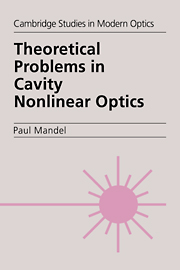Book contents
- Frontmatter
- Contents
- Introduction
- 1 Reduction of the Maxwell–Schrödinger equations
- 2 Parameter swept across a steady bifurcation I
- 3 Parameter swept across a steady bifurcation II
- 4 Optical bistability: Constant input
- 5 Optical bistability: Variable input
- 6 Multimode optical bistability
- 7 Free-running multimode lasers
- 8 Antiphase dynamics
- 9 Laser stability
- 10 Second harmonic generation
- 11 Saturable absorbers
- 12 Transverse effects in optical bistability
- Index
8 - Antiphase dynamics
Published online by Cambridge University Press: 16 October 2009
- Frontmatter
- Contents
- Introduction
- 1 Reduction of the Maxwell–Schrödinger equations
- 2 Parameter swept across a steady bifurcation I
- 3 Parameter swept across a steady bifurcation II
- 4 Optical bistability: Constant input
- 5 Optical bistability: Variable input
- 6 Multimode optical bistability
- 7 Free-running multimode lasers
- 8 Antiphase dynamics
- 9 Laser stability
- 10 Second harmonic generation
- 11 Saturable absorbers
- 12 Transverse effects in optical bistability
- Index
Summary
In a recent series of experimental papers, it has appeared that lasers that are well described by the simplified TSD rate equations (7.42)–(7.44) display what is called, in laser physics, antiphased dynamics. Its simplest manifestation is that when N modes oscillate, the total intensity displays many properties that are those of a single-mode laser. In the simplest experiment, the laser is initially in a steady state. A control parameter is suddenly changed and the relaxation toward the new steady state is recorded. This transient evolution is then Fourier analyzed to evaluate its frequency content. The result of this experiment is that each mode is characterized by as many frequencies as there are modes, whereas the total intensity, which is simply the sum of all modal intensities, is characterized by only one frequency. This frequency is the single-mode relaxation oscillation frequency (7.51) and is also the highest of the N frequencies. This property has been observed with a Nd-doped optical fiber laser [1]. Using a LiNdP4O12 (abbreviated as LNP) laser oscillating on two or three modes, it was shown that the noise spectrum of the laser displayed the same antiphase dynamics [2]. With the same laser, antiphase dynamics was also reported in the case where a feedback loop induces a chaotic output [3]. The feedback loop has the effect of injecting part of the output beam in the laser after each modal intensity has been subjected to a modulation. Antiphase dynamics also plays a significant role when a multimode laser undergoes a Feigenbaum cascade toward chaos. It has been reported that though the total intensity displays this usual route to chaos, the modal intensities do not [4].
- Type
- Chapter
- Information
- Theoretical Problems in Cavity Nonlinear Optics , pp. 91 - 104Publisher: Cambridge University PressPrint publication year: 1997



